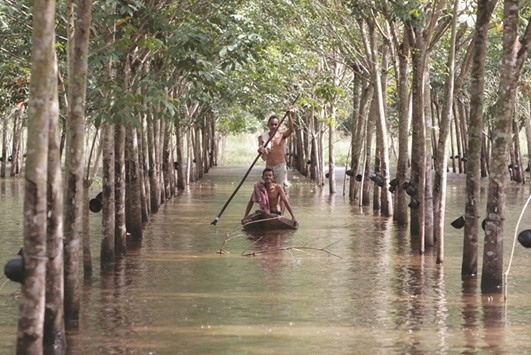First came drought, then came floods. Rubber farmers in Thailand’s south are counting the cost of extreme weather in the world’s top growing region. “From afar the trees look withered,” said 67-year-old Reang Onnuan, a lifelong rubber grower, looking out at the sea of water from which her trees protruded.
“I don’t know if tens or hundreds have already died,” she said, describing it as the worst flood she had ever seen.
Weeks of flooding because of unseasonal downpours have killed 45 people and brought a halt to rubber tapping at the height of the season in a key area of the world’s biggest exporter of natural rubber.
Concerns over what that could mean for global supply have fuelled a rally in international prices to near a four-year peak.
As a result of the floods, Thai output is expected to fall by 7.6% this year to 4.38mn tonnes, down from the 4.74mn tonnes previously expected, the Rubber Authority of Thailand said.
Thailand accounts for nearly 40% of the world’s natural rubber, most of which is used in car tyres. Nearly two-thirds of Thailand’s rubber growing area is in the south.
Thailand is one of the world’s most important exporters of agricultural commodities — including rice and refined sugar. In recent years, it has suffered weather extremes including droughts and heatwaves as well as floods.
The rubber group said it was still early to give a full assessment of the long-term damage, adding that rubber trees can recover if they are not under water for too long. Trees take about seven years to start to produce and have a productive lifespan of about 30 years.
In Nakhon Si Thammarat, hit by some of the worst floods, Poan Thongmak, 51, takes a boat every day to check on his rubber trees. His farm spans almost 1.8 hectares (4.5 acres).
“I don’t know how much damage the trees will have suffered by the end, or if any of the them will survive,” he said, looking out at waters which had receded from a high of two metres (6.5ft). Meteorologists forecast the rains will last until the end of the month.

Phon Tongmak, a rubber tree farmer (back), rows a boat in floodwaters in his rubber plantation with his friend at Cha-uat district in Nakhon Si Thammarat Province, southern Thailand.
